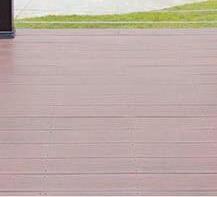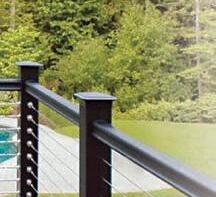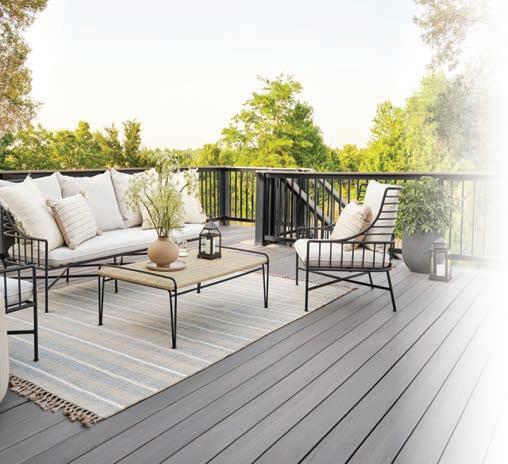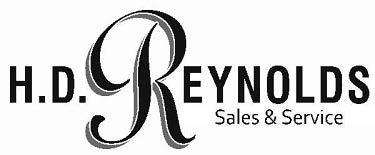


















































Various things come to mind when pondering outdoor entertaining. Outdoor living spaces run the gamut from expansive oases with a pool, hot tub and room to lounge to smaller areas with some seating that allows hosts and guests to enjoy some fresh air. One common theme in most outdoor living spaces, regardless of their size, is an area to cook, typically over an open flame.
Grilling is wildly popular. According to the grilling experts at Traeger, roughly 128 million households across the United States owned a grill in 2020. Grills are similarly popular in Canada, where a 2023 poll from Ipsos-Reid found that 78 percent of Canadians own a grill. Outdoor cooking is a staple of life in the United States and Canada, and this popular means to meal preparation can be made even more enjoyable with a few simple upgrades to an outdoor living space.
Natural gas grills are designed to be connected with a home’s natural gas line. That can make it more convenient to grill, particularly for people who grill often and do not want to deal with charcoal and propane tanks that require routine trips to a grocery store or other retailer to resupply. With a natural gas grill, cooks can fire up the grill at any time just like they would when using a gas stove indoors.
Incorporating a refrigerator into an outdoor living space can make outdoor cooking more convenient. Depending on the size of

the appliance, an outdoor refrigerator can store condiments and sauces, saving cooks the trouble of walking back and forth between indoor and outdoor living spaces to gather supplies for cooking. A slightly larger outdoor refrigerator also can be used to store the food that will be cooked on the grill, affording cooks more time to spend outdoors.
An outdoor living space that incorporates a pantry to store dishes and tools of the barbecuing trade, like spatulas and tongs, can make grill sessions easier for cooks. When planning a new outdoor living space, a pantry can be incorporated into the design. If augmenting an existing space, standalone pantries can provide similar functionality as built-in alternatives.
All those utensils and cooking instruments will ultimately need to be washed.
An outdoor sink ensures utensils and tools can be washed and dried outside, saving hosts the trouble of carrying items in at the end of the night only to return them to the outdoor pantry the following morning. An outdoor sink also makes it easier to rinse vegetables before cooking them over an open flame.
Grilling can be a rewarding but lonely undertaking. Grills often are set away from dining tables so guests can

comfortably converse and eat without being drowned out by the sizzle of the grill or overwhelmed by smoke that can come pouring out when opening the grill lid. A garden bar that’s adjacent to the grill can provide a gathering space for guests and ensure cooks aren’t spending the duration of a get-together going it alone.
Outdoor cooking is wildly popular, and might prove even more so when incorporating various convenient features into an exterior living space.

Camp atthebas e ofMount Grey lo ck ...close to allthe Berkshireshas to of fer Famil y Ca mpin g intheBerkshi res
mtgreylockcamp sitepark .c om 15ScottRd,Lanesborough 413-447-9419
OpenAprilthroughOct ob er Tent,Truck/Car/CamperVana nd RV camp sitesavaila bleforonenight, weekend ,montha nd /orthe2026season



*OfferavailableMarch1,2025 – June30,2025.Rebatesand/or financingbasedonthepurchaseofeligibleequipmentdefinedin promotionalprogram.PricingandrebatesinUSdollars. Additionalfeesincluding,butnotlimitedto,taxes,freight,setup anddeliverychargesmayapply.FinancingmustbethroughDLL orSheffieldusingoneoftheavailablefinancingoptions. Financingissubjecttocreditapproval.Customersmusttake deliverypriortotheendoftheprogramperiod.Somecustomers willnotqualify.Somerestrictionsapply.Offeravailableonnew equipmentonly.Priorpurchasesarenoteligible.Offervalidonly atparticipatingDealers.Offersubjecttochangewithoutnotice. Seeyourdealerfordetails.6YearWarrantyforNonCommercial,residentialuseonly.6YearWarrantyappliestoCS, CX,CK10,CK20,DK10,DK20,NSandNXmodelKIOTI tractorsandmustbepurchasedandregisteredbetween September1,2016 – June30,2025.Offervalidonlyat participatingDealers.Offersubjecttochangewithoutnotice. Seeyourdealerfordetails. © 2025KiotiTractorCompanya DivisionofDaedong-USA,Inc.










When it comes to mowing your lawn in the Berkshires, there’s more to consider than just picking the first mower you see. From unpredictable weather patterns to the unique terrain of the area, the right mower can make all the difference in keeping your lawn lush, healthy and well-maintained throughout the seasons.
For nearly 90 years, H.D. Reynolds has been a trusted name in Berkshire County for outdoor power equipment. Since 1937, the family-run business has helped customers find the perfect tools for their yards — and their experience has proven that no two lawns are the same. Here’s a guide to help you choose the right lawn mower for your Berkshire yard.
For smaller lawns — those under 1/3 acre or so — simpler is often better. Push mowers and reel mowers are perfect for homeowners looking to keep things light, affordable and eco-friendly. For the eco-conscious homeowner, the manual reel mower is another option to consider. These low-maintenance tools are a great fit for flat lawns and offer a quiet, simple solution that avoids any reliance on fuel or electricity.
SELF-PROPELLED MOWERS: A GREAT MIDDLE GROUND
If your lawn is a bit larger, or if you have some mild slopes in your yard, a self-propelled mower might be just what you need. These mowers offer the perfect balance between ease of use and efficiency, requiring much less physical effort than a push mower while still allowing you to main-

tain full control over the pace and direction.
RIDING MOWERS FOR LARGER YARDS: COMFORT & EFFICIENCY
For larger properties — think more than half an acre — riding mowers or zero-turn mowers can save you hours of work while also providing unmatched comfort. Riding mowers are ideal for those who have a lot of ground to cover and want the comfort of a seat and steering wheel. They excel on open spaces and can significantly reduce your mowing time, freeing you up for other activities. Many models also offer attachments for year-round utility, from snow plows to dethatchers.
When choosing a riding mower, also consider the engine size and horsepower, as this impacts its ability to handle tough terrain and thick grass. Look for durable construction and easy-to-access controls for a smooth and efficient mowing experience. Zero-turn mowers take things up a notch with a unique design
that allows you to make sharp turns and navigate obstacles with ease. When shopping for a riding mower, consider how much time you want to spend mowing and whether you want additional features like cruise control, adjustable seats or larger cutting decks. These mowers are built for speed and comfort, but it’s important to select one that fits the specific size and contours of your lawn.
Zero-turn mowers have become a favorite for homeowners and landscape professionals alike — especially in areas like the Berkshires, where navigating around trees, flower beds, and other landscaping elements is a regular task. These mowers offer exceptional maneuverability and precision, allowing you to cut around obstacles without missing a spot.
Selecting the right mower is just the first step. To en-
sure your investment continues to perform year after year, regular maintenance is a must. H.D. Reynolds is committed to keeping your lawn equipment in top shape. With in-house repair services ranging from simple tune-ups to more complex engine repairs, their team ensures that your mower stays in prime condition throughout the season.
Whether you’re a firsttime mower buyer or a seasoned landscaper, choosing the right equipment for your Berkshire property can make a big difference in the quality of your lawn. H.D. Reynolds is proud to offer top-of-the-line mowers, expert advice and reliable service to help you maintain your outdoor spaces yearround.
Visit their new location at 37 Nobodys Road or call (413) 743-2313 to speak with one of their experienced team members today. For more information, you can also visit reynoldslawnmower.com.

Living in the Berkshires means experiencing all the beauty of four seasons — but with that comes the challenge of dealing with fluctuating temperatures and humidity. One minute, the snow is coming down hard in February; the next, you’re dealing with spring showers that bring a whole new set of moisture-related problems. And when moisture sticks around, mold can quickly follow.
Jake Sawtelle, the co-owner of Dependable Roofing in Pittsfield, has seen it all when it comes to home maintenance in the Berkshires. Between the heavy snowfalls, wet springs and warm summer nights, Jake and his wife, Nicole, know firsthand how these weather patterns can create the right conditions for mold to grow in homes.
If you’ve ever noticed a musty smell, or worse, visible mold in your home, you know it’s a problem you don’t want to ignore. Mold can affect both your health and your home, but the good news is that with the simple precautions, you can stop it before it gets out of hand.
Mold thrives in places that are warm, moist and poorly ventilated — exactly the conditions we deal with during New England’s rainy seasons. Here’s where you’ll want to keep a close eye out for mold:
Showering in the Berkshires can sometimes feel like stepping into a sauna,
especially during those damp spring months. And all that steam and moisture can lead to mold growth, especially in poorly ventilated bathrooms. Jake recommends installing an exhaust fan that vents outdoors (if you don’t have one already). If a fan isn’t an option, cracking open a window after a hot shower can help air things out. Wiping down surfaces and keeping the bathroom dry is key, too.
Your laundry room might seem like a low-risk spot for mold, but think about all that moisture from washing and drying clothes — and if your dryer isn’t vented properly, you could be adding extra moisture to the air, making it easier for mold to grow. Jake advises homeowners
to make sure dryer vents are clear and lead to the outside, not just the attic or crawl space. Leaky washing machines or pipes can also cause hidden water damage that’s an ideal environment for mold to flourish.
Kitchens can be a mold hotspot, too. With the combination of cooking steam, leaks under the sink and possibly an old dishwasher, moisture often lingers. Jake recommends checking around sinks and dishwashers for any signs of leaks or standing water. Running a fan when you cook can help cut down on humidity, too.
The basements of Berkshire homes can be especially prone to mold, especially
when they’re unfinished or poorly ventilated. Moisture can seep in from outside, or condensation from temperature changes can create the perfect breeding ground for mold. Jake suggests using a dehumidifier to help keep moisture levels in check, and regularly checking for leaks in the foundation or around windows. The goal is to keep humidity levels between 30% and 50% to minimize mold risk.
Even though we don’t spend much time in our attics, they can still be a hotbed for mold, especially in older homes. In the winter, warm air rises from your living spaces, and without proper insulation and ventilation, the attic can trap moisture, causing mold to grow. After a snowstorm or heavy rain, it’s a good idea to check your attic for signs of water damage. This is
also a place where your roof might need some attention if leaks are contributing to mold problems.
If mold has already set in, don’t wait to address it. Mold remediation can be a tricky business, especially if it’s hidden behind walls or in hard-to-reach places. Jake and Nicole have the experience to identify mold and take care of it before it becomes a bigger issue.
Whether you’re trying to prevent mold from taking hold or dealing with an existing issue, the team at Dependable Roofing is here to help. With over 15 years of experience in roofing, siding and home maintenance across the Berkshires, Jake and Nicole have seen it all and are always ready to offer helpful advice.
Give them a call at (413) 281-5655 to get started on protecting your home.




































CARR HARDWARE
489 Pittsfield Rd., Suite A-110, Lenox, MA
413-442-0983 carrhardware.com
CLARK’S NURSERY
1210 Pleasant St., Lee, MA 413-243-0660 facebook.com/clarksnurserylee/
GREAT BARRINGTON AGWAY
30 Maple Ave., Great Barrington, MA 413-528-2390 agwayny.com
HELIA NATIVE NURSERY
95 East Rd., West Stockbridge, MA 413-528-1400 helianativenursery.com
JAESCHKE FRUIT & FLOWERS CENTER
736 Crane Ave., Pittsfield, MA 413-443-7180
NOBLE’S FARM STAND & FLOWER SHOP
390 E. New Lenox Rd., Pittsfield, MA 413-443-2210 noblesfarmstandflowershop.com
THE PLANT CONNECTOR
46 West St., Pittsfield, MA 413-769-8949 theplantconnector.com
TAFT FARMS 119 Park St., Great Barrington, MA 413-528-1515 taftfarmsgb.com
WAHCONAH ST. GREENHOUSES
100 Wahconah St., Pittsfield, MA 413-442-3833


SECOND DROP FARM
551 North Main St, Lanesborough, MA 413-822-0355 seconddropfarms.com
Second Drop Farm is a family-owned You-Pick berry and flower farm, farm store and cafe in Lanesborough, MA, offering a hands-on, nature-filled experience rooted in sustainability. Guests can harvest fresh strawberries, blueberries and flowers, such as lavender, while enjoying the peaceful beauty of the Berkshires and reconnecting with the land, community and simple joys of farm life.
WARD’S NURSERY & GARDEN CENTER
600 Main St., Great Barrington, MA 413-528-0166 wardsnursery.com
WHALEN NURSERY INC.
1820 N. Main St., She eld, MA 413-528-4077 whalennursery.com
WINDY HILL FARM
686 Stockbridge Rd., Great Barrington, MA 413-298-3217 windyhillfarminc.com
ZEMA’S NURSERY, INC.
154 Presbyterian Hill Rd., Stephentown, NY 518-733-5868
zemasnursery.com

1775 South State Rd., Cheshire, MA 413-442-4749 whitneysfarm.com

Whitney’s Farm is a family-owned market and garden center in the Berkshires, offering fresh produce, homemade baked goods, a full-service deli and plants for every season. With over 80 years of farming tradition, Whitney’s blends local flavor, quality and friendly service to bring the best of the farm to your table. Their garden center has a complete selection of garden supplies and solutions for your everyday needs.


Patios are popular gathering spaces when hosting warm weather affairs. Backyard barbecues are a staple of summertime entertaining, but in order to make the most of such affairs, homeowners first need a place for guests to gather. And more and more homeowners are looking to patios as their go-to spaces to host loved ones.
When contemplating a patio addition or renovation, homeowners will need to choose a material for the space. Options abound regarding patio materials, and the following rundown can help identify which material is best for them.
Pavers are incredibly popular among modern homeowners. Pavers come in a variety of colors, sizes and shapes, and that’s helped to
make them a highly versatile patio material that can help homeowners set their spaces apart from neighbors’ and friends’. Pavers require careful installation that makes this an ideal job to reserve for skilled, experienced professionals. One of the more notable characteristics of pavers is individual pieces can be replaced without affecting the entire patio, which can make repairs easier and less expensive.
Concrete was long a goto choice, but a tendency to crack has affected the viability of this material in the eyes of many homeowners. But concrete still has its proponents, as it tends to be a budget-friendly option. Staining and sealing can add to the appeal of a concrete patio, which is best installed by a skilled professional.

YourChoiceofTrexSelectinPeppleGreyorSaddle,Trex Transcend,areinstockandreadyforfreedelivery.Manynew Trexcolorarenowavailabe,withshortleadtimes.Stopdownand checkoutyounewdeck.AskforPaulorPatfordeckplanning. NotReadyforaTexdeck,CheckoutourSTKCedarDecking, MahoganyandPremiumPressureTreateddecking. Railingsystemsareinstock.Havethemincludedinyournew decklayout.

Brick is a durable material and provides a unique aesthetic, which can be appealing to homeowners who prioritize uniqueness when planning a patio. Bricks are not invulnerable to cracking, and that’s a variable homeowners must keep in mind when considering this material.
Flagstone offers a natural look that can emphasize and foster a connection with the great outdoors. Flagstone is a heavy material that requires professional installation. Flagstone is among the more expensive patio material options, but the overall cost of the project will depend on the size of the patio.
Maintenance is a notable factor to consider when examining patio materials.
The amount of maintenance could be relative to each property, but it’s also worth noting certain materials may require more TLC than others regardless of the setting. For example, a material like flagstone could require some extra attention to prevent staining. Patios are expensive additions, so homeowners will want to do all they can to keep a new one looking good. When considering materials, homeowners should speak with a contractor about maintenance and recognize how much time they will likely have to devote to upkeep. If time is short, then a material that’s more hands-off might be the best bet.
Patios are popular gathering spaces. The choice of patio material can go a long way toward determining how much homeowners get out of these spaces.

If you’ve lived through a few Berkshire summers, you know the drill: one week, heavy thunderstorms soak everything in sight; the next, it’s blazing hot and bone dry. These kinds of weather swings can leave even the healthiest lawns looking patchy, yellowed or downright scorched.
Tom Quirk, founder of Reliable Yardworks in Pittsfield, has spent more than 40 years designing and maintaining landscapes across the region. Through years of local experience — and a background in landscape architecture from UMass Amherst — he’s seen firsthand how our unique climate and soil types can complicate lawn care.
According to Quirk, many Berkshire lawns suffer from a mix of predictable issues — some caused by weather, others by mowing habits, pets or poor soil conditions. So, if your grass is looking less than lush this season, here are some common causes — and some practical, locally-informed ways to bring it back to life.
BROWN SPOTS FROM PETS
It turns out that one of the most common reasons for dry, brown patches is pet urine. While nitrogen is essential for grass growth, the high concentration found in dog urine can actually burn the lawn. Quirk often suggests setting up a designated spot for dogs and rinsing those areas with water to minimize damage.
MOWING TOO LOW?
THINK TALLER
One mistake Quirk often sees in Berkshire yards is cutting grass too short. Short lawns might look tidy, but they’re more vulnerable
to drought and stress. Taller grass, on the other hand, shades the roots and helps retain soil moisture. Quirk typically advises mowing high and sticking to the “one-third rule” — never cut off more than a third of the blade at once.
Although lawn diseases like leaf blight and powdery mildew might seem like problems for more humid regions, they can (and do) affect lawns here — especially during wet summers. Quirk recommends aerating and dethatching lawns in cooler seasons to keep diseases from taking hold.
SOIL PH COULD BE THE SILENT SABOTEUR
Another issue Quirk regularly encounters in local yards is improper soil pH. Grass doesn’t grow well if the soil is too acidic or too alkaline. He often starts with a basic soil test and makes gradual adjustments using lime or sulphur, depending on the results.
Insects like grubs, chinch bugs and other root-feeding pests can quickly turn a healthy lawn into a patchy mess. Reliable Yardworks frequently inspects damaged areas to identify pest problems early, and uses targeted treatments where needed.
Quirk often points out that a lawn’s watering schedule can make or break it — especially during July and August. Instead of frequent, shallow watering, he recommends deeper, less frequent

sessions to encourage stronger root growth. And early mornings — before 9 a.m. — are best to avoid evaporation.
In some cases, lawns may be too far gone and need a complete overhaul. That’s where Reliable Yardworks’ design expertise comes in. Quirk and his team use CAD technology and 3D renderings to create detailed plans before any work begins, helping homeowners visualize the end result and make informed choices.
Thanks to decades of hands-on experience, Quirk also prioritizes local materials and plants that thrive in the Berkshires’ climate — increasing survival rates

and making long-term upkeep easier.
“Every yard in this area has its own set of challenges,” Quirk says, “but with the right tools and approach, you can turn any space into something beautiful.”
Whether you’re dealing with brown patches, pest issues or you’re ready for a full landscape redesign, Quirk and his team at Reliable Yardworks are ready to help. With a seasoned crew, modern equipment and a commitment to high-quality, transparent service, they’ve been a trusted name in the Berkshires for over 40 years.
To get started on your own lawn or landscaping project, visit reliableyardworks.com or call (413) 441-6465.



















“YankeeHomedidanamazingjob removingouroldbathtuband installingastandaloneshowerinits place. Theyquoted2daysand finisheditallin1day.Extremely happywiththeresults,would recommendYankeeHome100 percent!!”-MikeF.
Outdoor living spaces can be welcoming areas to spend time in nature. Such spaces expand the possibilities for entertaining, as they tend to have more room for guests than home interiors, and they enable people to enjoy sunshine, fresh air and the sounds and sights of wildlife in relaxing settings. When planning outdoor living areas, homeowners must not underestimate the significance of drainage.
Patios, pergolas, decks and landscaping can increase comfort and convenience for homeowners. In fact, connection to the outdoors ranked high on the top 10 list of design drivers in “The Future of Home Design,” a survey conducted by the New Home Trends Institute in collaboration with Pro Builder. Fifty-eight percent of survey respondents said connection to the outdoors will be an important influence on their future design choices.
When planning outdoor living spaces, it is easy to focus on aesthetic appeal and the finished project. But homeowners must carefully consider the impact these modifications will have on the landscape, particularly how they will affect drainage so it will not compromise the integrity of the new design nor impact the surrounding home and other structures.

Without proper drainage, water can accumulate and that can lead to various issues. Here’s a more in-depth look at why drainage is crucial when planning outdoor living areas.
When water is allowed to collect on patios and around hardscaping features, it can cause the materials to deteriorate over the years. Pavers or stones may shift, crack or become discolored, eventually becoming less safe.
Pooling water can make hard surfaces slippery, possibly leading to falls and other accidents. It also can make lawns soggy and muddy, which can limit easy access to areas of the yard.




Water can cause erosion of surrounding soil, leading to uneven surfaces. Erosion also may threaten the stability of nearby structures.
Water has a way of finding cracks and crevices and thus entering structures. Rainwater that is not properly directed away from a home may eventually seep into the foundation, causing anything from structural damage to mold and mildew to making damp areas conducive to pests.
Homeowners have different options when it comes to drainage in their outdoor living areas. Masonry experts will design patios with a slight slope to allow water
to naturally flow away from the surface toward drainage areas. Together with wellplaced gutters and downspouts, water can be directed away from the home.
Homeowners also might want to consider two different types of drain systems. French drains are a system that involves a trench filled with perforated pipe and gravel to allow water to drain from the yard. French drains can redirect water away from living areas. Channel drains are perimeter drains around patios and other hardscaping that act as an interceptor to prevent water from going where it isn’t desired. They are narrow trenches with a grate on top so that water enters and flows away.


























































